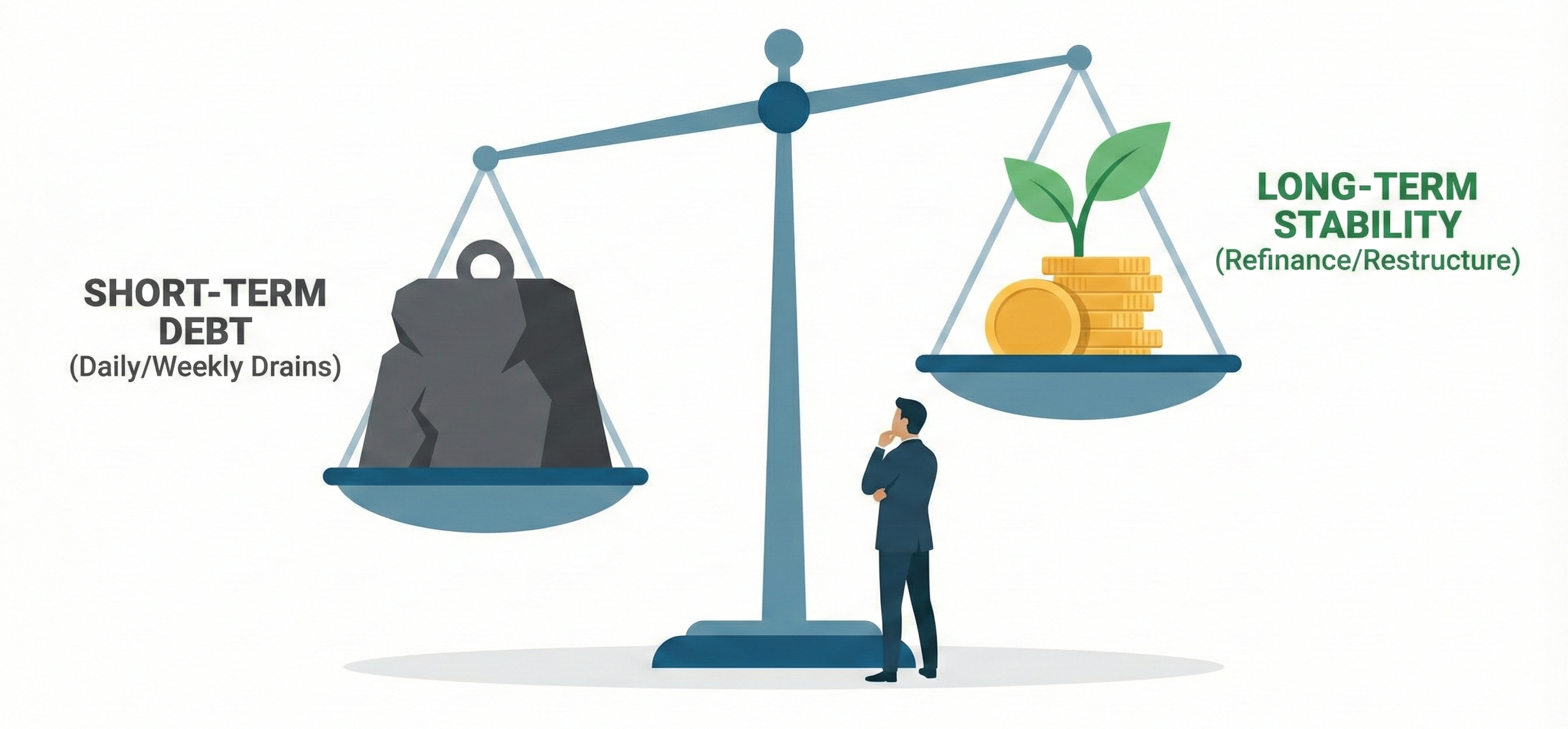“No more romanticizing about how cool it is to be an entrepreneur. It’s a struggle to save your company’s life – and your own skin – every day of the week.”
-—Spencer Fry, CarbonMade co-founder
General Requirements (takes about 5-minutes or less to apply online)
680 FICO score (Transunion or Experian FICO model 8.0 or similar)
Less than -15% operating loss in the last year of business
Last 2-Years of filed Business Tax Returns; Last 1-Year of filed Personal Tax Returns
Last 3-months of bank statements; copy of Driver’s License
Affordable Business Financing: A Guide to Long-Term Business Loans
Navigating business financing can be challenging, particularly when seeking long-term capital for growth without straining monthly cash flow.
This guide helps small business owners find financing with extended repayment periods and lower monthly payments.
We'll cover the basics of long-term loans, different lender types, government-backed programs, the trade-off between payment size and total cost, and financing application preparation.
Decoding Long-Term Financing: Fueling Your Business Growth
Understanding long-term financing is key to making informed borrowing decisions aligned with your business's goals and capacity.
What Qualifies as Long-Term Financing for Small Businesses?
For small businesses, long-term financing usually means loans repaid over more than one year, often three to 25 years. The most common form is a term loan: a lump sum repaid with interest over a set period.
This financing typically supports significant investments, not daily operational costs.
Common uses include:
● Purchasing Fixed Assets: Machinery, equipment, commercial real estate.
● Funding Business Expansion: New locations, markets, or product lines.
● Business Acquisition: Buying an existing business.
● Significant Working Capital Needs: Some programs, like the SBA 7(a), allow terms up to 10 years for working capital.
This differs from short-term loans (repaid within a year) or business lines of credit, which are revolving funds for ongoing expenses like inventory or cash flow gaps. Long-term loans provide a defined sum for a specific major purpose with a clear maturity date. Matching the financing type to the need is crucial; using short-term funds for long-term assets can strain cash flow.
The Mechanics: How Loan Term & Interest Rate Dictate Your Monthly Outlay
Your monthly payment depends on the principal amount, interest rate, and loan term.
● The Loan Term Effect: A longer repayment period means lower monthly payments. Repaying $100,000 over 20 years results in smaller payments than over 10 years.
● The Interest Rate Effect: A higher interest rate increases the cost of borrowing and the monthly payment.14 Lower rates reduce payments. Rates depend on the economy, borrower risk, and loan specifics (fixed vs. variable).
● Amortization Explained: Most long-term loans use an amortization schedule. Each fixed payment covers both principal and interest. Initially, more goes to interest; later, more goes to principal. This affects the total interest paid, especially over long terms.
For a $100,000 loan: at 6% over 10 years, the monthly payment is ~$1,110. Extended to 25 years, it drops to ~$644. But if the 25-year rate is 9%, the payment rises to ~$839.
This shows how term and rate interact.
Beyond the Interest Rate: Understanding Annual Percentage Rate (APR)
The interest rate isn't the full cost. The Annual Percentage Rate (APR) includes the interest rate plus fees (origination, processing, closing costs) as an annualized percentage. Comparing APRs gives a truer picture of borrowing costs. A loan with a lower rate but high fees might have a higher APR than one with a slightly higher rate and low fees. Some lenders use a "factor rate" (e.g., 1.2), multiplied by the loan amount for total repayment.
Always convert factor rates to APR for accurate comparisons.
Navigating the Lender Landscape: Who Offers Long-Term Capital?
Small businesses have several potential sources for long-term financing, each with unique traits.
The Stalwarts: Traditional Banks
Major national and smaller community banks offer conventional term loans, commercial real estate (CRE) loans, and participate in SBA programs. Conventional terms are often up to 5-7 years, but CRE or SBA loans can reach 25 years.
Banks may offer competitive rates for strong businesses but have strict requirements: good credit (680+), 2+ years in business, solid revenue/cash flow, collateral, and extensive documentation.
The process can be slow.
Community Pillars: Credit Unions
Credit unions are non-profit, member-owned institutions offering similar products to banks (term loans, SBA loans, lines of credit). They might offer slightly better rates or a more relationship-focused approach. Requirements often mirror banks: solid operating history (2+ years 56), good credit, strong financials, and potential collateral. They actively participate in SBA programs.
The Digital Disrupters: Online Lenders (Fintech/Alternative Lenders)
Online lenders offer faster access to capital with potentially looser requirements than traditional lenders. They focus on short-term (months) and medium-term (up to ~3 years) loans, lines of credit, and invoice financing.
Truly long-term financing (10+ years) is less common, though some facilitate SBA loans.
Advantages are speed (funding in days/hours 2) and accessibility (6-12 months in business, lower credit scores may suffice 12).
The main drawback is cost: rates and APRs are typically much higher. Borrowers must scrutinize terms, understand the APR, and beware of predatory practices.
Government Support: An Introduction to SBA-Backed Loans
The U.S. Small Business Administration (SBA) facilitates access to capital. Except for disaster loans, the SBA doesn't lend directly.5 It provides a guarantee to partner lenders (banks, credit unions, etc.), covering a large portion of the loan (up to 75-85% for many 7(a) loans 6) if the borrower defaults.5This backing enables lenders to offer better terms 5:
● Longer Repayment Terms: Up to 10 years (working capital/equipment), 25 years (real estate)
● Lower Down Payments: Often 10%, potentially less than conventional.
● Expanded Access: Helps creditworthy businesses unable to get conventional loans on reasonable terms.
● Competitive, Capped Rates: Rates negotiated but subject to SBA maximums.
Primary SBA programs for long-term financing are 7(a) and CDC/504, with Microloans for smaller needs. The guarantee makes lenders more willing to offer extended terms.
Unlocking Potential with SBA 7(a) Loans: Flexibility and Reach
The SBA 7(a) program is the agency's flagship, known for flexibility and broad use, making it a top choice for long-term financing.1
The Workhorse Loan: Understanding the SBA 7(a) Guarantee
The 7(a) program uses partner lenders, with the SBA providing a partial guarantee (up to 85% for loans ≤$150k, 75% for loans >$150k 6). SBA Express loans have lower guarantees (e.g., 50% 6) for faster processing. This reduced lender risk encourages favorable terms.The standard 7(a) maximum loan is $5 million 5, though sub-programs like SBA Express have lower caps ($500,000 5).The 7(a)'s strength is versatility. Funds can be used for 5:
● Working capital (short- and long-term)
● Purchasing machinery, equipment, supplies
● Acquiring/improving real estate
● Refinancing existing business debt (conditions apply)
● Business expansion or acquisition
This allows addressing multiple needs with one loan.
Stretching Payments: Loan Terms Up to 10 or 25 Years
The 7(a) program offers extended terms, lowering monthly payments.5 Maximum terms depend on use 1:
● Real Estate: Up to 25 years.
● Working Capital: Up to 10 years.
● Equipment/Machinery: Up to 10 years (or longer if asset's useful life exceeds 10 years).
Lenders set the shortest appropriate term based on repayment ability, up to these maximums.6 Long maturities spread out principal repayment. Most 7(a) loans fully amortize without balloon payments, offering predictability.1
Decoding 7(a) Interest Rates
Rates are negotiated between borrower and lender but capped by the SBA.5 Maximums are tied to a benchmark (usually the Prime Rate) plus an SBA-set spread.5The maximum spread depends on loan amount and maturity.5 For variable-rate loans (Dec 2024 guidelines 6):
● ≤ $50k: Prime + 6.5%
● $50k - $250k: Prime + 6.0%
● $250k - $350k: Prime + 4.5%
● $350k: Prime + 3.0%
Fixed rates are allowed, often with slightly higher maximum spreads.5 Fixed rates offer payment stability; variable rates might start lower but can increase if Prime rises.1
Are You Eligible? Key Requirements for 7(a) Loans
Qualification involves meeting SBA and lender requirements.
SBA Eligibility Basics:
● For-profit business operating in the U.S
● Meet SBA size standards
● Owner equity investment demonstrated
● Unable to get reasonable non-government financing
● Not in ineligible industries (passive investment, lending, gambling)
● Good character (e.g., no delinquent government debt)
Lender Underwriting Criteria:
● Creditworthiness: Personal (680+) and business credit assessed. FICO SBSS (small business score) score may be used.
● Ability to Repay: Strong revenue and positive cash flow needed. Financials analyzed.
● Time in Business: Lenders usually prefer 2+ years.
● Personal Guarantee: Required from owners with ≥20% stake. Personal assets are at risk.
● Collateral: Lenders must collateralize loans maximally with available business assets (RE, equipment, A/R, inventory). Personal assets might be considered. Cannot be denied solely for insufficient collateral. May be waived for smaller loans (≤$50k).
The 7(a)'s flexibility and long terms make it powerful for lowering monthly payments, but businesses must meet both SBA and lender standards, including the personal guarantee.
General Requirements (takes about 5-minutes or less to apply online)
680 FICO score (Transunion or Experian FICO model 8.0 or similar)
Less than -15% operating loss in the last year of business
Last 2-Years of filed Business Tax Returns; Last 1-Year of filed Personal Tax Returns
Last 3-months of bank statements; copy of Driver’s License
Building Your Future: The SBA 504 Loan for Fixed Assets
The SBA 504 loan program specifically finances major fixed assets, promoting growth and job creation.
Financing Growth: Purpose-Built for Real Estate & Major Equipment
The 504 loan funds long-term assets for growth. Eligible uses:
● Purchasing land and existing buildings.
● Constructing new facilities or renovating existing ones.
● Buying long-term machinery and equipment.
● Associated land/site improvements.
Funds cannot be used for working capital, inventory, debt consolidation (except specific refinancing), or speculative investments. It's ideal for capital expenditures, less so for general operations compared to 7(a).
The 504 Structure: Partnering with CDCs and Lenders
The 504 structure involves three parties:
1. Senior Lender (Bank/CU): Provides ~50% of project cost, secured by a first lien.
2. Certified Development Company (CDC): Non-profit, SBA-certified entity provides up to 40% via an SBA-guaranteed debenture, secured by a second lien.
3. Small Business Borrower: Contributes ≥10% equity (down payment). Increases to 15% for startups (<2 yrs) or special-purpose properties, 20% if both.
Businesses work with both the CDC and the senior lender. This structure enables favorable terms but can be more complex than a 7(a) application.
Locking in Stability: Long-Term Fixed Interest Rates
A major benefit is the rate structure on the CDC portion:
● CDC Loan (up to 40%): Fixed interest rate for the entire term (10, 20, or 25 years), offering payment predictability. Rate set when the debenture is sold, pegged above the 10-year U.S. Treasury rate.
● Senior Lender Loan (~50%): Rate and terms negotiated separately. Can be fixed or variable, often with shorter terms (e.g., 5-10 years), potentially needing refinancing.
The CDC/SBA portion term is 10, 20, or 25 years, matching asset life.
Qualifying for a 504: Eligibility Criteria
Besides general SBA rules (for-profit U.S. business 31), 504 has specific criteria:
● Financial Thresholds: Tangible net worth < $15 million; average net income < $5 million (after tax, preceding 2 years).
● Job Creation/Public Policy Goals: Project must meet SBA economic development goals, usually job creation/retention (e.g., 1 job per $65k-$100k of CDC loan) or other goals like rural development, minority/woman/veteran ownership, energy efficiency, etc.
● Collateral: Primarily the fixed assets financed.62 Personal guarantees from principal owners (≥20%) usually required.
The 504 loan is excellent for major property/equipment investments. The long-term fixed rate on the CDC part offers stability, and the lower down payment (often 10%) makes large projects more accessible.
Traditional Routes: Securing Long-Term Loans from Banks & Credit Unions
Established businesses with strong financials might explore conventional (non-SBA) long-term loans directly from banks and credit unions.
Beyond SBA: Conventional Term Loan Options
Banks and credit unions offer their own term loans funded by their capital, without SBA guarantees.1 Underwriting is based solely on the institution's risk assessment.
Conventional term loan repayment periods are often shorter than SBA options, frequently 1-7 years. Getting conventional terms beyond 10 years (outside of CRE) can be difficult without government backing.
However, conventional Commercial Real Estate (CRE) loans can have amortization up to 25 years.
Rates can be fixed or variable 1, depending heavily on creditworthiness, loan size/term, collateral, market conditions, and lender relationship. Highly qualified businesses might get rates competitive with SBA loans, but higher-risk businesses may face much higher rates.
The Gatekeepers: Typical Requirements
Conventional long-term financing typically requires meeting strict criteria:
● Credit Score: Strong personal (often 700s+) and business credit needed.
● Time in Business: Established businesses preferred, minimum 2 years common. Startups struggle to qualify.
● Revenue & Cash Flow: Consistent profitability and cash flow to cover existing debts plus the new loan are critical. Minimum revenue thresholds (e.g., $100k-$250k+) and DSCR (often ≥1.25) are analyzed.
● Collateral: Secured loans are common, especially for larger/longer loans. Business or personal assets may be pledged.3 Unsecured options usually have lower limits/shorter terms/higher rates.3
● Documentation: Comprehensive business/personal financials, tax returns, legal docs, business plan required (See Section 9).
These demands mean conventional loans are most accessible to mature, financially healthy businesses with strong credit and collateral. Others likely need SBA support or alternatives.
Evaluating Offers: Comparing Rates and Terms
Compare conventional offers carefully:
● Shop Multiple Lenders: Get quotes from several banks/credit unions.
● Compare APR: Focus on APR for true cost comparison, including fees.
● Scrutinize Fees: Identify all costs (origination, appraisal, closing, prepayment penalties 35)
● Leverage Relationships: An existing positive relationship might help, but isn't guaranteed. A familiar banker might advocate better.
The Online Alternative: Assessing Long-Term Loans from Fintech Lenders
Online lenders (fintech/alternative) are popular for speed and streamlined applications, but their suitability for long-term financing with the lowest payments needs careful review.
Longer Horizons Online: What Options Exist?
Most online lenders focus on rapid short- or medium-term funding.2 Common products:
● Short-Term Loans: 3-24 month terms.
● Medium-Term Loans: Up to 5-year terms.
● Business Lines of Credit: Often up to 5-year terms.
● Invoice Financing/Factoring: Very short-term.
● Merchant Cash Advances (MCAs): High-cost advances against future sales.
Finding online lenders offering conventional terms significantly beyond 5 years (approaching SBA's 10-25 years) is less common. Some platforms facilitate SBA loans 60 or have specific long-term products, but this isn't typical. Businesses seeking the absolute longest terms are less likely to find them here compared to SBA or conventional CRE loans.
The Trade-offs: Speed and Convenience vs. Potential Costs
Online lenders offer distinct pros and cons:
● Pros:
○ Speed: Faster application/funding (days/hours).
○ Convenience: Online application, potentially less documentation.
○ Accessibility: More lenient criteria (shorter time in business: 6-12 months; lower credit scores).
● Cons:
○ Cost: Generally much higher interest rates/APRs than banks/SBA.
○ Shorter Terms: Focus on shorter terms leads to higher monthly payments relative to amount borrowed.
○ Fees: Can include substantial origination, late payment, prepayment fees.
○ Predatory Lending Risk: Ease can mask unfavorable terms; caution needed.
Qualification Hurdles: How They Differ from Banks
Online lenders often have less stringent standards:
● Credit Score: Many accept lower scores (low-mid 600s, even 500s 12) vs. banks' 680+ baseline.
● Time in Business: Often require only 6-12 months vs. banks' 2+ years.
● Revenue: Minimums may apply but might be lower than banks. Heavy emphasis on recent cash flow via linked bank accounts.
● Collateral: Unsecured options more common, though larger/riskier loans may still require it or a personal guarantee.
Online lenders cater to businesses needing fast cash or those not meeting bank criteria. While useful for immediate needs, their typical structure (higher rates, shorter terms) aligns less with securing the longest terms and lowest payments for major investments. Thorough due diligence, APR calculation, and understanding all fees are crucial.
The Long Game: Balancing Low Monthly Payments vs. Total Loan Cost
Achieving the lowest monthly payment often means extending the loan term, but this increases the total borrowing cost.
The True Cost of Time: Why Longer Terms Increase Total Interest
A longer term reduces monthly payments by spreading principal repayment over more installments. However, this leads to paying significantly more in total interest.13Interest is calculated on the outstanding principal balance. With a longer term, the balance decreases more slowly, meaning a larger balance accrues interest for longer. Lenders also see longer terms as riskier, which might sometimes lead to slightly higher interest rates, further increasing total cost.
Calculating the Impact: Examples and Using Loan Calculators
Consider a $250,000 loan at 8% APR:
● Scenario 1: 10-Year Term (120 months)
○ Monthly Payment (P&I): ~$3,033
○ Total Interest Paid: ~$113,990
○ Total Repayment: ~$363,990
● Scenario 2: 25-Year Term (300 months)
○ Monthly Payment (P&I): ~$1,929
○ Total Interest Paid: ~$328,778
○ Total Repayment: ~$578,778
(Approximate calculations using standard formulas.)
Extending the term from 10 to 25 years cuts the monthly payment by over $1,100 but more than doubles the total interest paid (over $214,000 more).
Use online business loan calculators 24 to model scenarios with your potential loan details. These tools show estimated payments, total interest, and amortization schedules, clarifying the financial implications.
Strategic Decision-Making for Your Business's Financial Health
Choosing the optimal term involves balancing priorities:
● Cash Flow: Lower payments offer flexibility and reduce shortfall risk.
● Profitability: Higher total interest reduces long-term profitability.
● Business Stage: Startups/growing businesses might prioritize cash flow (lower payments/longer term). Stable businesses might prioritize minimizing total interest (higher payments/shorter term).
● Return on Investment (ROI): If the loan funds a high-return project, the higher interest cost of a longer term might be acceptable if lower payments are needed to make it feasible.
● Refinancing: Might start with a longer term for affordability, planning to refinance later if finances improve. Consider future conditions and prepayment penalties.
The "right" term depends on your business's situation, risk tolerance, projections, and priorities. Balance the appeal of low payments with the long-term impact on total cost.
Preparing Your Application: Positioning Your Business for Success
Securing long-term financing, especially from banks or via SBA programs, requires thorough preparation. Being organized improves approval chances and may lead to better terms.
Gathering Your Arsenal: The Essential Document Checklist
Requirements vary, but most lenders need core documents. Prepare these in advance.
Making Your Case: The Importance of a Strong Business Plan & Loan Proposal
Lenders need context beyond financials. A strong Business Plan and Loan Proposal are vital.
● Business Plan: Outlines mission, products/services, market analysis, management team, strategies, operations, and financial projections (showing viability and repayment capacity).
● Loan Proposal: Details funding amount requested, justifies use ("sound business purpose" 65), and outlines repayment plan, supported by projections.
These documents show preparedness, strategic thinking, market understanding, and a credible plan for using funds and repaying debt.
Understanding the Numbers: Creditworthiness and Financial Metrics
Lenders rely on quantitative data:
● Credit Scores: Personal (often 680+ for bank/SBA 12) and business scores (like FICO SBSS 65) are critical. Check scores beforehand.
● Cash Flow: Historical and projected cash flow analyzed to ensure enough income to cover existing debts plus the new loan.
● Debt Service Coverage Ratio (DSCR): (Net Operating Income / Total Debt Service) assesses repayment ability. Lenders often require ≥1.25
● Collateral: Available assets and their value impact risk assessment. Strong collateral helps, especially for weaker credit/larger loans
Lenders assess past performance and future projections. The owner's personal financial health is closely linked to the business loan application
Tips to Enhance Approval Odds and Secure Favorable Terms
Proactive steps can improve chances:
● Prepare Thoroughly: Gather documents early; ensure financials are accurate and complete
● Know Your Financials: Understand credit scores, DSCR, revenue trends, cash flow.
● Develop Compelling Plan/Proposal: Create clear, realistic, well-supported documents.
● Target Appropriate Lenders: Research lenders whose products match your needs/qualifications. Consider SBA Preferred Lenders for potentially faster processing.
● Cultivate Relationships: Prior banking relationships might help with traditional lenders.
● Strengthen Profile: Improve credit scores, pay down debt (improves DSCR), ensure tax compliance, identify collateral. Offer a larger down payment.
The application process is rigorous. Success requires preparation, financial understanding, and a convincing narrative about future prospects and repayment ability.
Conclusion: Charting Your Course for Sustainable Growth
Securing long-term financing with manageable payments requires strategic planning.
Key takeaways:
1. Multiple Pathways: Options include traditional banks, credit unions, online lenders, and government-backed programs. The best choice depends on business needs and qualifications.
2. SBA Loans Key for Long Terms/Low Payments: SBA 7(a) and 504 programs facilitate longer terms (up to 25 years) and lower down payments via government guarantees reducing lender risk.
3. State/Local Programs Supplement: Pennsylvania offers programs (like PIDA) providing low-interest loans or other benefits, often requiring engagement with specific partner organizations.
4. Online Lenders Prioritize Speed: Valuable for quick capital but typically offer shorter terms and higher APRs, less ideal for lowest long-term payments.
5. Term vs. Total Cost Trade-off: Longer terms lower monthly payments but increase total interest paid. Balance cash flow needs with long-term profitability using loan calculators.
6. Preparation is Crucial: Rigorous applications (especially bank/SBA) demand meticulous preparation: financials, business plan, understanding key metrics, and potentially strengthening your profile.
By understanding these dynamics, assessing needs, exploring all options, and preparing diligently, small business owners can secure the long-term financing needed for sustainable growth while maintaining manageable payments.
General Requirements (takes about 5-minutes or less to apply online)
680 FICO score (Transunion or Experian FICO model 8.0 or similar)
Less than -15% operating loss in the last year of business
Last 2-Years of filed Business Tax Returns; Last 1-Year of filed Personal Tax Returns
Last 3-months of bank statements; copy of Driver’s License
We can help you Navigate through the Small Business Financing maze.
The sooner you act, the more options you’ll have.
Schedule a consultation today and take the first step toward saving your business and your future.
Remember, more business debt isn’t the answer. A more effective business strategy is.
Click to setup an introduction meeting to discuss your situation and next best steps.
Bernarsky Advisors
Business Finance and Strategy Advice
Refinance. Restructure. Reorganize.
(See more of our articles about Business Finance and Strategy below…)
WHAT IS THE BEST AND SAFEST WAY FOR YOUR BUSINESS TO DEAL WITH HIGH BUSINESS DEBT PAYMENTS?
It is NOT by stopping ACH payments.
It is NOT by taking on another business loan.
It is NOT ALWAYS a Refinancing
It is NOT by entering into a debt settlement program.
Find out the BEST strategies to get your Business back to where it was



















